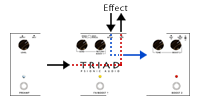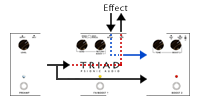This section explains the signal flow in the Triad's FX/Boost 1 stage. As relatively few guitar pedals offer a series/parallel mixing stage, this can be a new area for most players to explore.
This is really a combination Aux Send/Return and a Series/Parallel mixer combined into one. This is commonly found in recording studios, and allows a lot of "studio tricks" to find a home on a pedal board. Using the Triad FX/Boost 1 stage in parallel allows the player to keep the dry signal analog at all times, only blending in digital effects such as delay or reverb behind the analog dry signal.
Take time to read each subsection listed above so you can best make use of the Triad's features in your personal tone quest.

In series mode there is one path that runs from the Preamp through the loop and any connected effects, with the signal either entirely changed (distortion, overdrive, wah, etc) or the balance between the dry sound and the effect sound adjusted within the effect (chorus, pedal delay, reverb, etc).
That works for overdrives, distortions, eq, and other analog devices. But it has some shortcomings for effects like reverb and delay, particularly with digital pedals. What's the point of having a really great guitar and a really great amp if you're going to run the whole signal through a $2 digital converter chip?

In parallel mode there are two paths - one inside the Triad from the Preamp to Boost 2, and one running from the Preamp through the loop to the Boost 2 stage, where it is mixed with the direct path.
This allows you to run the delay or reverb pedal in 100% wet mode, so your dry signal stays inside the Triad and is always analog, while the delay or reverb is mixed in behind your dry signal.
In addition to not running your entire tone through cheap converters, this allows for natural sounding "spillover" transitions.
But experiment with Series and Parallel Modes and different pedals - there are lots of creative options available. Try a wah, whammy, or overdrive (or all three at once) in parallel!

The FX/Boost 1 Bypass mode signal path is the same in both Series and in Parallel Modes.